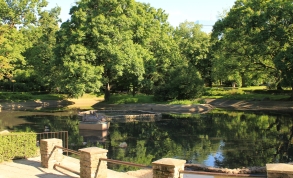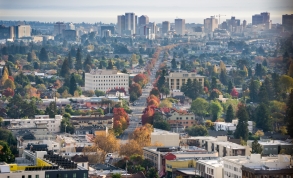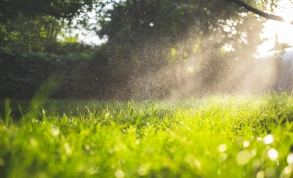Abstract
Lisbon, the capital city of Portugal, suffers from high levels of traffic and air pollution which has an impact on residents' health and wellbeing. Green spaces and street trees can help mitigate these adverse impacts, but the wide ranging environmental, socio-economic and health benefits remain difficult to quantify. Poor valuation of benefits, coupled with hefty maintenance costs, leads to inadequate maintenance or premature removal of these green spaces and compromises their potential to deliver ecosystem services benefits. This study used the STRATUM (Street Tree Resource Analysis Tool for Urban forest Managers) programme to quantify urban trees structure, function, management needs, costs, and benefits. The ecosystem service (ecoservice) value of over 41,000 street trees in Lisbon was assessed, finding substantial air pollution reduction, as well as economic benefits.
Intervention overview
Lisbon, the capital city of Portugal, had a population of 564,000 in 2001, with the metropolitan area containing around 30% of the total population of the country, despite only covering 3.3% of the land area. Heavy traffic in the city due to commuters contributes to air pollution, which is recognised by WHO as one of the greatest environmental risks to health, causing 4.2 million premature deaths worldwide (Ambient Air Pollution, 2021) and 2,936 deaths in Portugal in 2016 (Ambient Air Pollution Attributable Deaths, 2018). Portugal's metropolitan population has grown since 2001 (Population Stat, 2022).
Urban trees are known to improve air quality, both directly through pollutant uptake and by reducing energy requirements: trees provide shading, lower temperatures, reduce summer air conditioning needs, and sometimes reduce winter heating loads by reducing wind speeds. They can also improve water management, reduce noise levels, increase biodiversity, and moderate urban heat islands. They may also improve the aesthetics of an urban environment and provide economic benefits. However, management costs can be high, and the presence of trees can raise the value of homes, disadvantaging people of lower socio-economic status (Jelks et al., 2021).
This study assessed the impact of 41,247 urban trees in Lisbon on carbon storage and sequestration, air pollution, energy savings, stormwater runoff, property values as well as the economic benefits. In 2004, data was collected on tree species, dimensions, condition and location, management needs, and other attributes, for a sample of 3,003 street trees. There were 78 different species of street trees found within the sample. Celtis australis (common name European nettle) and Tilia (lime) were the most common tree species (each accounted for 16% of street trees), followed by Jacaranda mimosifolia (jacaranda; 10%), Platanus (plane; 8.6%), Acer negundo (box elder; 6.9%), and Tipuana tipu (rosewood; 4.6%). Tree stocking was 22.1% (full stocking is considered 2 trees every 15 m of street length), and there were 0.07 trees per inhabitant.
A computer programme or software called STRATUM (Street Tree Resource Analysis Tool for Urban forest Managers), which is part of the software i-Tree, was used to quantify urban forest characteristics, costs, and benefits of the trees. STRATUM was developed for trees in the United States (US), so tree growth data for Lisbon trees was lacking, therefore US tree species were matched to each species in Lisbon according to similar characteristics. Matching tree species was achieved as follows: 1) first, the ten most abundant species' total tree height, crown height, and crown diameter were recorded; 2) fitted Lowess curves for US species were compared visually to scatterplots of the crown height and crown diameter measurements for similar species in Lisbon; 3) a taxonomic approach was used to assign US reference trees to the Lisbon trees. These surrogate US trees allowed Lisbon data on climate, buildings, air pollutant concentrations, and rainfall patterns to be inputted into the STRATUM software to model information on energy savings, air quality benefits, atmospheric CO2 reductions, stormwater runoff reductions, property value benefits, and overall economic benefits.
Outcomes
Lisbon's street trees were assessed as storing 20,070,426 kg of CO2 each year and annually sequestering 1,776,999 kg CO2. Due to energy savings, 632,608 kg CO2 were avoided per year. However, their maintenance and decomposition released 379,745 kg and 169,183 kg CO2 annually, resulting in a net total of 1,860,679 kg/year avoided CO2 that would otherwise be in the atmosphere. The tree species with the most potential to remove CO2 were A. negundo, Platanus, and Populus (black poplar), with 94.3kg, 86.0 kg, and 68.9kg CO2 per tree annually, respectively.
The trees removed 24,905 kg air pollutants from the atmosphere and avoided 5,244 kg of air pollutants from energy savings annually. However, they released 4,576 kg of BVOC (biogenic volatile organic hydrocarbons) which have an adverse impact on ozone air quality, thus reducing air pollutants by a total of 25,573 kg annually. The different tree species were not equal in their impact on air quality; some species released a negligible amount of BVOCs, with Tipuana tipu alone releasing 34% of BVOCs despite only accounting for 4.6% of trees. The species with the greatest potential for air pollution reduction were Platanus, Celtis australis, and Fraxinus angustifolta (narrow-leaved ash) removing 1.20 kg, 1.00 kg, and 0.88 kg air pollution per tree annually, respectively.
Energy savings from the trees came to US$254,185 (US$6.16/tree) annually. Tree species that produced the greatest energy savings were large deciduous trees and those with large leaves. Conversely, species that provided the smallest energy benefits had smaller mature sizes and smaller leaves. The street trees intercepted around 186,773 m3 of rainfall annually (4.5 m3/tree), saving US$1.97 million in stormwater runoff (US$48 /tree). Species with the highest potential savings value in stormwater runoff per tree were Platanus (US$88.7), C. australis (US$69), and Populus ($57). Property value in Lisbon associated with the presence of the trees was estimated to be US$5.97 million annually (US$145 /tree). Species adding the greatest value per tree were Platanus (US$274), A. negunda (US$264), and C. australis (US$178).
Lisbon spent around US$1.9 million (US$45.64/tree) annually on tree maintenance, but, due to the energy, GHG emissions, air quality, stormwater, and property value benefits, the net benefit of the trees was US$8.4 million per year.
Feasibility and potential impact of scale up
It is important to consider the trees' resilience, especially given our changing climate. Five species (C. australis, Platanus spp., Tilia, A. negundo, J. mimosifolia) accounted for 58% of all street trees and produced 72% of total benefits. If one of these species succumbed to pests, disease, or drought, a large proportion of the tree population could be wiped out, threatening the high level benefits the trees provide. So, although these species are tolerant to growing conditions, an effort to increase species diversity should be made to mitigate the risk of future threats.
While property value can be an indicator of aesthetic, social, psychological and economic benefits, if these trees are unevenly distributed throughout communities they may exacerbate inequalities: new trees which raise the price of properties may result in green gentrification, making land inaccessible to those of lower socio-economic status meaning they don't reap the mental and physical benefits of their less marginalised counterparts; give them a lower sense of community; and risk displacement due to land prices (Jelks et al., 2021). So, while the authors note increased property values as a benefit, this example not only illustrates the need to account for unintended consequences for marginalised people when implementing climate mitigation measures, but it also demonstrates the need for collaboration between academic fields.
Lisbon's economic benefit from stormwater far exceeded the comparator cities, but street tree rainfall interception rate was similar. Lisbon invested a large amount of capital in stormwater management prior to the study, so the large economic benefit observed from runoff should be taken with caution, as it may not be transferable to other regions.
References
Academic profile / relevant organisation’s page
- Soares, A. L., Rego, F. C., McPherson, E. G., Simpson, J. R., Peper, P. J., & Xiao, Q. (2011). Benefits and costs of street trees in Lisbon, Portugal. Urban Forestry & Urban Greening, 10(2), 69–78. https://doi.org/10.1016/j.ufug.2010.12.001
Supplementary information
- Ambient (outdoor) air pollution. (2021). Retrieved 11 August 2022, from https://www.who.int/news-room/fact-sheets/detail/ambient-(outdoor)-air-…
- Ambient air pollution attributable deaths. (2018, July 6). [Ambient air pollution deaths]. The World Health Organization. https://www.who.int/data/gho/data/indicators/indicator-details/GHO/ambi…
- Population Stat (2022). Lisbon, Portugal Population. https://populationstat.com/portual/lisbon
- Jelks, N. O., Jennings, V., & Rigolon, A. (2021). Green Gentrification and Health: A Scoping Review. International Journal of Environmental Research and Public Health, 18(3). https://doi.org/10.3390/ijerph18030907
Contact
- Dr. Ana Luísa Soares, Universidade Técnica de Lisboa, Email: [email protected]



